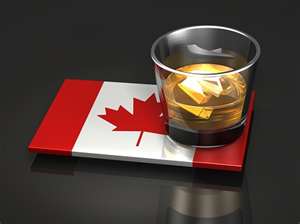Canadian whiskies are blended multi-grain liquors made primarily from corn with supplements of wheat, barley, or rye. According to the country’s law, Canadian whisky must be mashed, distilled, and aged in Canada. There are no specific grain percentage standards as in the US. The only requirement is that resulting products “possess the aroma, taste, and character generally attributed to Canadian whisky.”
Rye was a standard ingredient in the early days of Canadian whisky-making and the terms Rye whisky and Canadian whisky are used interchangeably. A whisky meeting all other requirements may legally be labeled “Canadian Whisky,” “Canadian Rye Whisky,” or “Rye Whisky” whether it contains rye or not. Actually, rye is used in small amounts in most Canadian whiskies to give a spicy flavor.
All spirits used in making a Canadian whisky must be aged at least three years in wooden barrels. Barrels can be new or previously used, charred or raw wood, but cannot be greater than 700 liters capacity. The final product must contain at least 40% alcohol by volume. There is no maximum limit on alcohol content. Most Canadian whiskies are aged at least four to six years. Nearly all are blended from different grain whiskies of different ages to achieve the consistency of flavor that buyers have come to expect. Crown Royal tastes about the same today as when first produced in 1939 to honor the visit of King George VI and Queen Elizabeth.
The first distillery in Canada began making spirits in 1769 in Quebec City. Many new immigrants were from Scotland and Ireland, home of some of the finest whiskies made, and they wanted grain left over from harvest season distilled into whisky. By 1840 there were 200 distilleries in Canada.
Liquor became big business in Canada in 1919 when the 18th amendment made it illegal to manufacture, sell, or transport alcohol in the US. This prevented American distillers from producing more liquor and also cost them all their aged stock.
 Canadian distillers recognized this tragic blunder as an opportunity and began to change their production to meet the tastes of US drinkers. Rye whiskey was popular in the US at the time. Major distillers in Canada, who primarily produced rum, began making whisky with rye but found it was expensive to work with and it produced whisky with a harsh taste. They blended in other grains, particularly corn, and soon adopted corn as the main ingredient. It made the drink smoother and cheaper than a straight rye whisky.
Canadian distillers recognized this tragic blunder as an opportunity and began to change their production to meet the tastes of US drinkers. Rye whiskey was popular in the US at the time. Major distillers in Canada, who primarily produced rum, began making whisky with rye but found it was expensive to work with and it produced whisky with a harsh taste. They blended in other grains, particularly corn, and soon adopted corn as the main ingredient. It made the drink smoother and cheaper than a straight rye whisky.
This new blend became popular in Canada and also began to flow into the US. Hiram Walker’s distillery (producing what would become Canadian Club) in Windsor, Ontario, was directly across the river from Detroit, Michigan. Bootleggers using fast smuggling boats quickly took advantage, and trucks loaded with contraband whisky came across every remote stretch of the Canadian border.
When Prohibition ended in 1933, with US distilleries having no inventory, the federally approved importation of 3,314,433 gallons of whisky came mostly from Canadian distilleries. Canada remained the prime source of liquor until US distillers were able to market sufficiently aged products. Even then demand for Canada’s whisky remained high. US drinkers had become fond of the light, smooth taste of Canadian and preferred it to what they’d been drinking before.
The US now imports more than $500 million worth of Canadian whisky each year. A result of this boom can be seen in the expansion of major Canadian distilleries and, specifically, in Montreal where various buildings, libraries, and hospitals bear the name Bronfman, the founding family of Seagram’s. Ironically, US whiskey is now being smuggled into Canada because of high liquor taxes there.
_______________
“I saw a notice that said ‘Drink Canada Dry,’ and I’ve just started.” – Brendan Behan
“I don’t even know what street Canada is on.” – Al Capone, noted Canadian whisky importer
